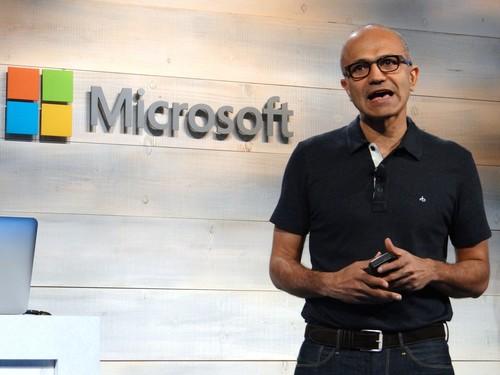Microsoft now loves Linux.
This was the message from Microsoft CEO Satya Nadella, standing in front of an image that read "Microsoft [heart symbol] Linux," during a Monday webcast to announce a number of services it had added to its Azure cloud, including the Cloudera Hadoop package and the CoreOS Linux distribution.
In addition, the company launched a marketplace portal, now in preview mode, designed to make it easier for customers to procure and manage their cloud operations.
Microsoft is also planning to release an Azure appliance, in conjunction with Dell, that will allow organizations to run hybrid clouds where they can easily move operations between Microsoft's Azure cloud and their own in-house version.
The declaration of affection for Linux indicates a growing acceptance of software that wasn't created at Microsoft, at least for the sake of making its Azure cloud platform as comprehensive as possible.
For decades, the company tied most of its new products and innovations to its Windows platform, and saw other OSes, such as Linux, as a competitive threat. Former CEO Steve Ballmer once infamously called Linux a cancer.
This animosity may be evaporating as Microsoft is finding that customers want cloud services that incorporate software from other sources in addition to Microsoft. About 20 percent of the workloads run on Azure are based on Linux, Nadella admitted.
Now, the company considers its newest competitors to be the cloud services offered by Amazon and Google.
Nadella said that by early 2015, Azure will be operational in 19 regions around the world, which will provide more local coverage than either Google or Amazon.
He also noted that the company is investing more than $4.5 billion in data centers, which by Microsoft's estimation is twice as much as Amazon's investments and six times as much as Google's.
To compete, Microsoft has been adding widely-used third party software packages to Azure at a rapid clip. Nadella noted that Azure now supports all the major data integration stacks, such as those from Oracle and IBM, as well as major new entrants such as MongoDB and Hadoop.
The results seem to be paying off. Today Azure is generating about $4.48 billion in annual revenue for Microsoft, and we are "still at the early days," of cloud computing, Nadella said.
The service attracts about 10,000 new customers per week. About 2 million developers have signed on to Visual studio online since its launch. The service runs about 1.2 million SQL databases.
CoreOS is now actually the fifth Linux distribution that Azure offers, joining Ubuntu, CentOS, OpenSuse, and Oracle Linux (a variant of Red Hat Enterprise Linux). Customers can also package their own Linux distributions to run in Azure.
CoreOS was developed as a lightweight Linux distribution to be used primarily in cloud environments. Officially launched in December, CoreOS is already offered as a service by Google, Rackspace, DigitalOcean and others.
Cloudera is the second Hadoop distribution offered on Azure, following Hortonworks. Cloudera CEO Mike Olson joined the Microsoft executives onstage to demonstrate how easily one can use the Cloudera Hadoop software within Azure.
Using the new portal, Olson showed how to start up a 90-node instance of Cloudera with a few clicks. Such a deployment can be connected to an Excel spreadsheet, where the user can query the dataset using natural language.
Microsoft also announced a number of other services and products.
Azure will have a new type of virtual machine, which is being called the "G Family." These virtual machines can have up to 32 CPU cores, 450GB of working memory and 6.5TB of storage, making it in effect "the largest virtual machine in the cloud," said Scott Guthrie, who is the Microsoft executive vice president overseeing Azure.
This family of virtual machines is equipped to handle the much larger workloads Microsoft is anticipating its customers will want to run. It has also upped the amount of storage each virtual machine can access, to 32TB.
The new cloud platform appliance, available in November, will allow customers to run Azure services on-premise, which can provide a way to bridge their on-premise and cloud operations. One early customer, integrator General Dynamics, plans to use this technology to help its U.S. government customers migrate to the cloud.
Joab Jackson covers enterprise software and general technology breaking news for The IDG News Service. Follow Joab on Twitter at @Joab_Jackson. Joab's e-mail address is Joab_Jackson@idg.com
Join the CIO Australia group on LinkedIn. The group is open to CIOs, IT Directors, COOs, CTOs and senior IT managers.





